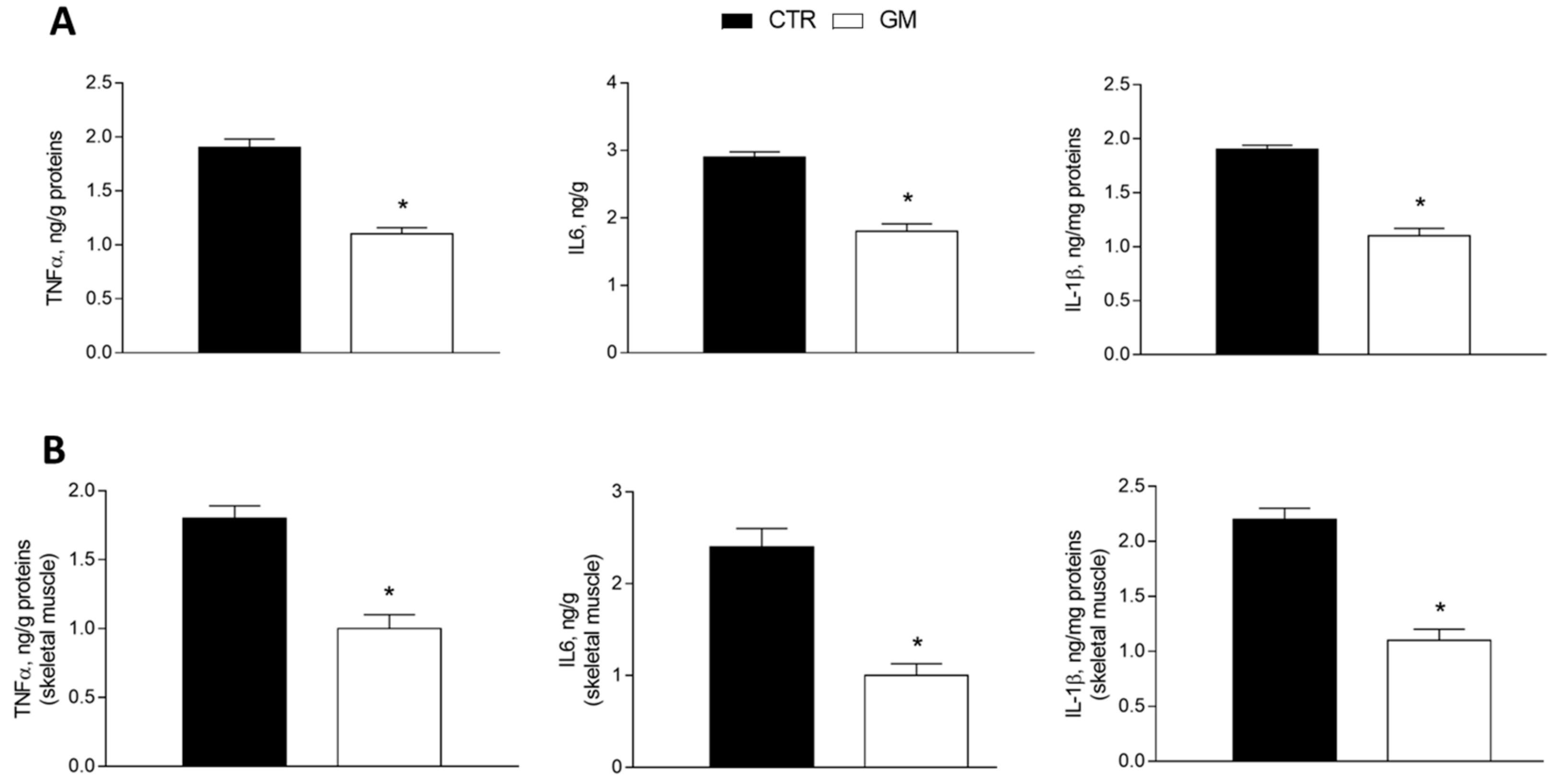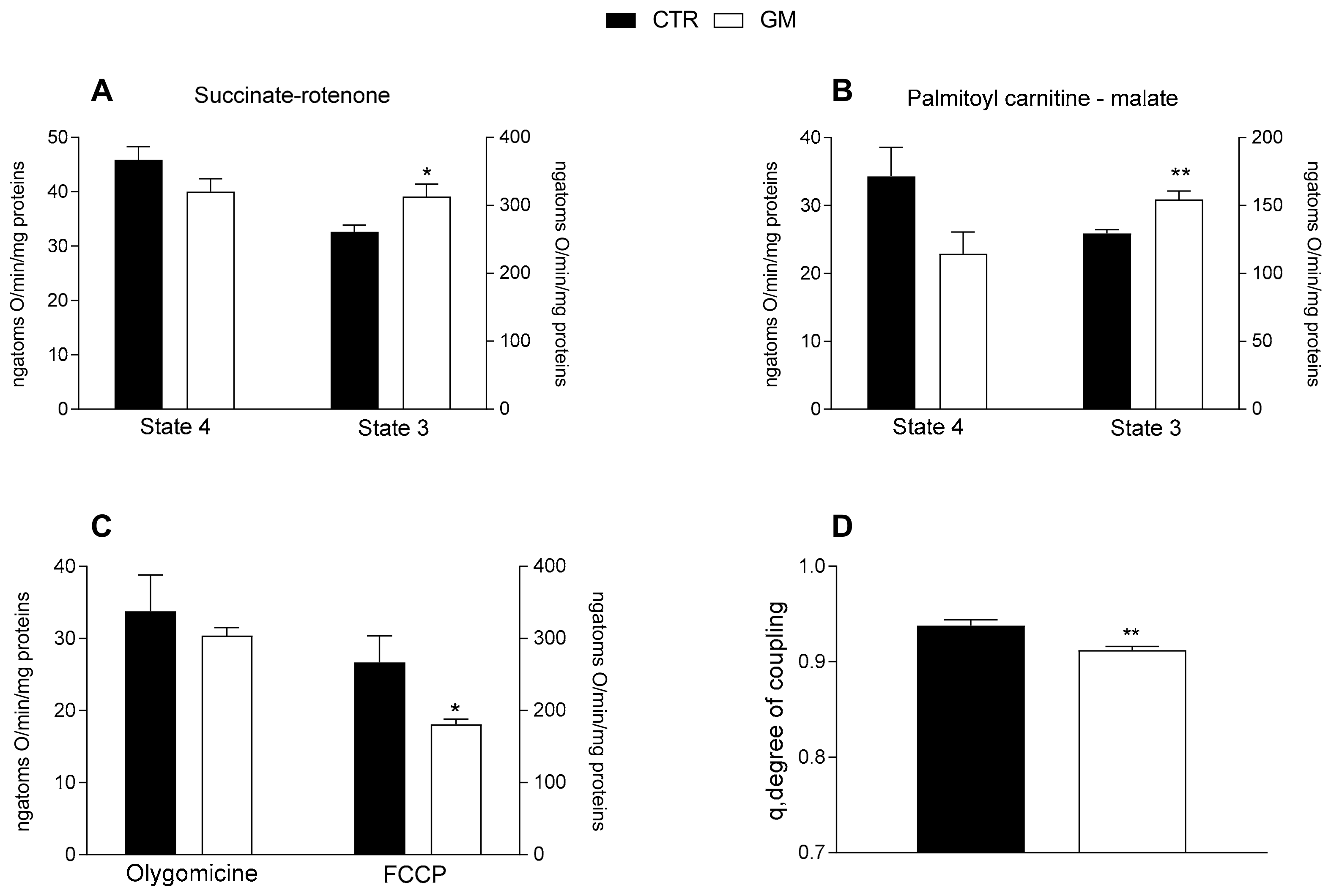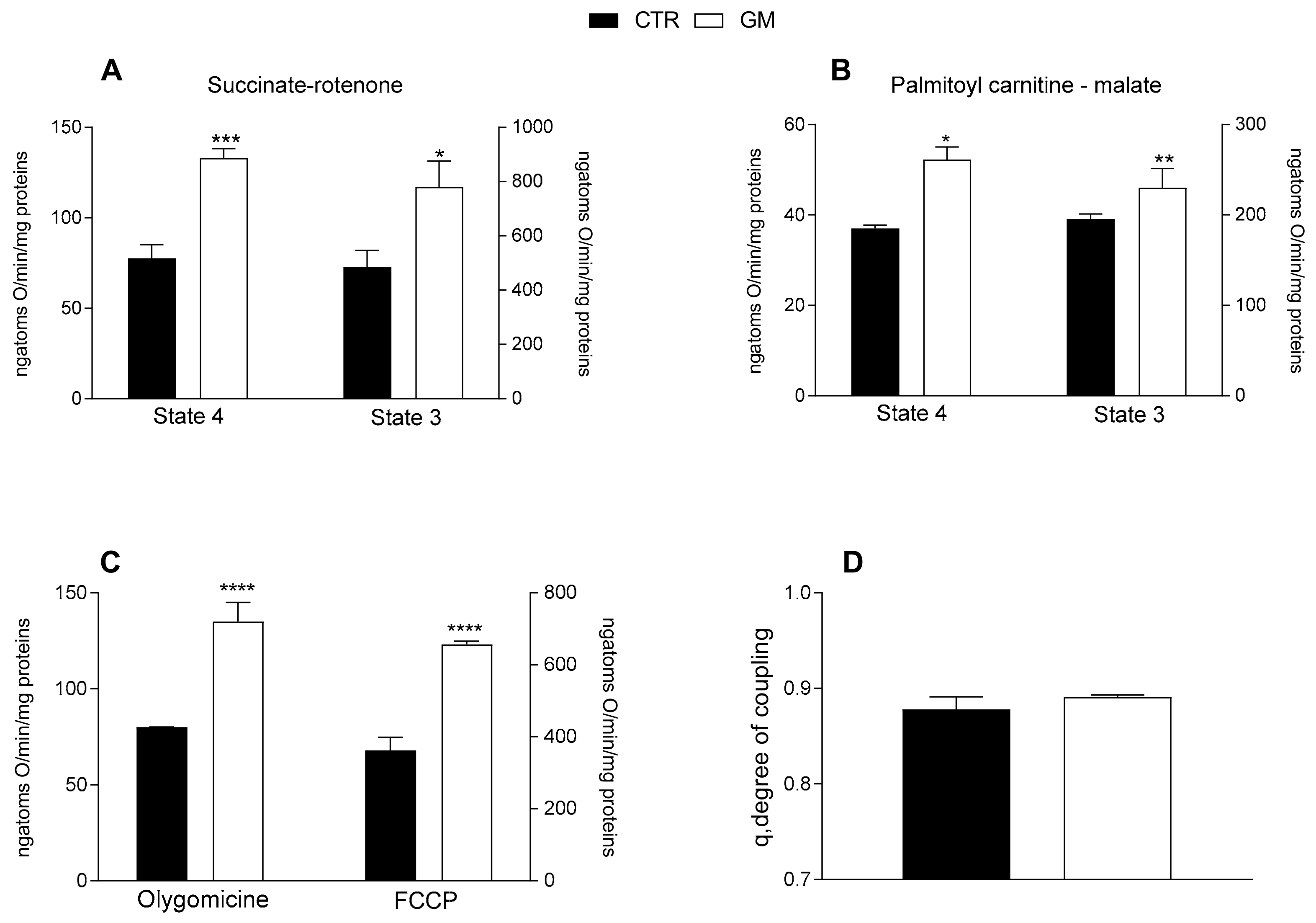Goat Milk Supplementation Modulates the Mitochondrial Metabolic Flexibility and Orexin-A Levels Influencing the Inflammatory Pattern in Rats
Abstract
1. Introduction
2. Materials and Methods
2.1. Animals and Chemicals
2.2. Body Composition and Energy Balance
2.3. Mitochondrial Preparation and Analysis
2.4. Evaluation of Inflammatory Markers
2.5. Evaluation of Redox Status
2.6. Evaluation of Orexin-A Serum Concentration
2.7. Statistical Analyses
3. Results
3.1. Goat Milk Administration Modulates Body Weight Gain with No Changes in Body Composition
3.2. Modulation of Liver and Skeletal Muscle Inflammatory Profile in Goat Milk-Supplemented Rats
3.3. Liver and Skeletal Muscle Mitochondrial Oxidative Capacity Is Modulated by the Administration of Goat Milk
3.4. Oxidative Stress and Antioxidant/Detoxifying Defense Are Improved by Goat Milk in Both Liver and Skeletal Muscle
3.5. Orexin-A Serum Levels Are Strongly Modulated by Goat Milk Treatment
4. Discussion
5. Conclusions
Author Contributions
Funding
Institutional Review Board Statement
Data Availability Statement
Conflicts of Interest
References
- Pereira, P.C. Milk Nutritional Composition and Its Role in Human Health. Nutrition 2014, 30, 619–627. [Google Scholar] [CrossRef]
- Kliem, K.E.; Givens, D.I. Dairy Products in the Food Chain: Their Impact on Health. Annu. Rev. Food Sci. Technol. 2011, 2, 21–36. [Google Scholar] [CrossRef] [PubMed]
- Yackobovitch-Gavan, M.; Phillip, M.; Gat-Yablonski, G. How Milk and Its Proteins Affect Growth, Bone Health, and Weight. Horm. Res. Paediatr. 2017, 88, 63–69. [Google Scholar] [CrossRef]
- Melnik, B. Milk—A Nutrient System of Mammalian Evolution Promoting mTORC1-Dependent Translation. Int. J. Mol. Sci. 2015, 16, 17048–17087. [Google Scholar] [CrossRef] [PubMed]
- Ilesanmi-Oyelere, B.L.; Kruger, M.C. The Role of Milk Components, Pro-, Pre-, and Synbiotic Foods in Calcium Absorption and Bone Health Maintenance. Front. Nutr. 2020, 7, 578702. [Google Scholar] [CrossRef]
- Norris, J.M.; Pietropaolo, M. Controversial Topics Series: Milk Proteins and Diabetes. J. Endocrinol. Investig. 1999, 22, 568–580. [Google Scholar] [CrossRef] [PubMed]
- Marangoni, F.; Pellegrino, L.; Verduci, E.; Ghiselli, A.; Bernabei, R.; Calvani, R.; Cetin, I.; Giampietro, M.; Perticone, F.; Piretta, L.; et al. Cow’s Milk Consumption and Health: A Health Professional’s Guide. J. Am. Coll. Nutr. 2019, 38, 197–208. [Google Scholar] [CrossRef] [PubMed]
- Melnik, B.C. Milk—The Promoter of Chronic Western Diseases. Med. Hypotheses 2009, 72, 631–639. [Google Scholar] [CrossRef]
- Rice, B.H.; Quann, E.E.; Miller, G.D. Meeting and Exceeding Dairy Recommendations: Effects of Dairy Consumption on Nutrient Intakes and Risk of Chronic Disease. Nutr. Rev. 2013, 71, 209–223. [Google Scholar] [CrossRef]
- Albenzio, M.; Santillo, A.; Caroprese, M.; Ciliberti, M.G.; Marino, R.; Sevi, A. Effect of Stage of Lactation on the Immune Competence of Goat Mammary Gland. J. Dairy Sci. 2016, 99, 3889–3895. [Google Scholar] [CrossRef]
- Caroli, A.M.; Chessa, S.; Erhardt, G.J. Invited Review: Milk Protein Polymorphisms in Cattle: Effect on Animal Breeding and Human Nutrition. J. Dairy Sci. 2009, 92, 5335–5352. [Google Scholar] [CrossRef] [PubMed]
- Kalač, P.; Samková, E. The Effects of Feeding Various Forages on Fatty Acid Composition of Bovine Milk Fat: A Review. Czech J. Anim. Sci. 2010, 55, 521–537. [Google Scholar] [CrossRef]
- Nagahata, H.; Fuse, M.; Umehara, K.; Gondaira, S.; Higuchi, H.; Hisaeda, K.; Kumano, Y. Evaluation of the Health Status of Mammary Glands and Compositional Changes in Udder-half Milk Obtained from Dairy Goats for Milk Quality Management. Anim. Sci. J. 2022, 93, e13714. [Google Scholar] [CrossRef] [PubMed]
- Sarti, L.; Martini, M.; Brajon, G.; Barni, S.; Salari, F.; Altomonte, I.; Ragona, G.; Mori, F.; Pucci, N.; Muscas, G.; et al. Donkey’s Milk in the Management of Children with Cow’s Milk Protein Allergy: Nutritional and Hygienic Aspects. Ital. J. Pediatr. 2019, 45, 102. [Google Scholar] [CrossRef]
- Lionetti, L.; Cavaliere, G.; Bergamo, P.; Trinchese, G.; De Filippo, C.; Gifuni, G.; Gaita, M.; Pignalosa, A.; Donizzetti, I.; Putti, R.; et al. Diet Supplementation with Donkey Milk Upregulates Liver Mitochondrial Uncoupling, Reduces Energy Efficiency and Improves Antioxidant and Antiinflammatory Defences in Rats. Mol. Nutr. Food Res. 2012, 56, 1596–1600. [Google Scholar] [CrossRef]
- Cimmino, F.; Catapano, A.; Villano, I.; Di Maio, G.; Petrella, L.; Traina, G.; Pizzella, A.; Tudisco, R.; Cavaliere, G. Invited Review: Human, Cow, and Donkey Milk Comparison: Focus on Metabolic Effects. J. Dairy Sci. 2023, 106, 3072–3085. [Google Scholar] [CrossRef]
- Haenlein, G.F.W. Goat Milk in Human Nutrition. Small Rumin. Res. 2004, 51, 155–163. [Google Scholar] [CrossRef]
- Stergiadis, S.; Nørskov, N.P.; Purup, S.; Givens, I.; Lee, M.R.F. Comparative Nutrient Profiling of Retail Goat and Cow Milk. Nutrients 2019, 11, 2282. [Google Scholar] [CrossRef] [PubMed]
- Park, Y.W.; Juárez, M.; Ramos, M.; Haenlein, G.F.W. Physico-Chemical Characteristics of Goat and Sheep Milk. Small Rumin. Res. 2007, 68, 88–113. [Google Scholar] [CrossRef]
- Raynal-Ljutovac, K.; Lagriffoul, G.; Paccard, P.; Guillet, I.; Chilliard, Y. Composition of Goat and Sheep Milk Products: An Update. Small Rumin. Res. 2008, 79, 57–72. [Google Scholar] [CrossRef]
- Zhou, S.J.; Sullivan, T.; Gibson, R.A.; Lönnerdal, B.; Prosser, C.G.; Lowry, D.J.; Makrides, M. Nutritional Adequacy of Goat Milk Infant Formulas for Term Infants: A Double-Blind Randomised Controlled Trial. Br. J. Nutr. 2014, 111, 1641–1651. [Google Scholar] [CrossRef] [PubMed]
- Bernard, L.; Toral, P.G.; Chilliard, Y. Comparison of Mammary Lipid Metabolism in Dairy Cows and Goats Fed Diets Supplemented with Starch, Plant Oil, or Fish Oil. J. Dairy Sci. 2017, 100, 9338–9351. [Google Scholar] [CrossRef] [PubMed]
- Imperatore, R.; Palomba, L.; Cristino, L. Role of Orexin-A in Hypertension and Obesity. Curr. Hypertens. Rep. 2017, 19, 34. [Google Scholar] [CrossRef] [PubMed]
- Mavanji, V.; Pomonis, B.; Kotz, C.M. Orexin, Serotonin, and Energy Balance. WIREs Mech. Dis. 2022, 14, e1536. [Google Scholar] [CrossRef] [PubMed]
- Goforth, P.B.; Myers, M.G. Roles for Orexin/Hypocretin in the Control of Energy Balance and Metabolism. In Behavioral Neuroscience of Orexin/Hypocretin; Lawrence, A.J., De Lecea, L., Eds.; Current Topics in Behavioral Neurosciences; Springer International Publishing: Cham, Switzerland, 2016; Volume 33, pp. 137–156. ISBN 978-3-319-57534-6. [Google Scholar]
- Mavanji, V.; Pomonis, B.L.; Shekels, L.; Kotz, C.M. Interactions between Lateral Hypothalamic Orexin and Dorsal Raphe Circuitry in Energy Balance. Brain Sci. 2024, 14, 464. [Google Scholar] [CrossRef] [PubMed]
- Trinchese, G.; Cavaliere, G.; Canani, R.B.; Matamoros, S.; Bergamo, P.; De Filippo, C.; Aceto, S.; Gaita, M.; Cerino, P.; Negri, R.; et al. Human, Donkey and Cow Milk Differently Affects Energy Efficiency and Inflammatory State by Modulating Mitochondrial Function and Gut Microbiota. J. Nutr. Biochem. 2015, 26, 1136–1146. [Google Scholar] [CrossRef]
- Mollica, M.P.; Mattace Raso, G.; Cavaliere, G.; Trinchese, G.; De Filippo, C.; Aceto, S.; Prisco, M.; Pirozzi, C.; Di Guida, F.; Lama, A.; et al. Butyrate Regulates Liver Mitochondrial Function, Efficiency, and Dynamics in Insulin-Resistant Obese Mice. Diabetes 2017, 66, 1405–1418. [Google Scholar] [CrossRef] [PubMed]
- Trinchese, G.; Cavaliere, G.; De Filippo, C.; Aceto, S.; Prisco, M.; Chun, J.T.; Penna, E.; Negri, R.; Muredda, L.; Demurtas, A.; et al. Human Milk and Donkey Milk, Compared to Cow Milk, Reduce Inflammatory Mediators and Modulate Glucose and Lipid Metabolism, Acting on Mitochondrial Function and Oleylethanolamide Levels in Rat Skeletal Muscle. Front. Physiol. 2018, 9, 32. [Google Scholar] [CrossRef]
- Hartree, E.F. Determination of Protein: A Modification of the Lowry Method That Gives a Linear Photometric Response. Anal. Biochem. 1972, 48, 422–427. [Google Scholar] [CrossRef]
- Cairns, C.B.; Walther, J.; Harken, A.H.; Banerjee, A. Mitochondrial Oxidative Phosphorylation Thermodynamic Efficiencies Reflect Physiological Organ Roles. Am. J. Physiol.-Regul. Integr. Comp. Physiol. 1998, 274, R1376–R1383. [Google Scholar] [CrossRef]
- Barja, G. Mitochondrial Free Radical Production and Aging in Mammals and Birds. Ann. N. Y. Acad. Sci. 1998, 854, 224–238. [Google Scholar] [CrossRef] [PubMed]
- Cimmino, F.; Catapano, A.; Trinchese, G.; Cavaliere, G.; Culurciello, R.; Fogliano, C.; Penna, E.; Lucci, V.; Crispino, M.; Avallone, B.; et al. Dietary Micronutrient Management to Treat Mitochondrial Dysfunction in Diet-Induced Obese Mice. Int. J. Mol. Sci. 2021, 22, 2862. [Google Scholar] [CrossRef] [PubMed]
- Cavaliere, G.; Trinchese, G.; Penna, E.; Cimmino, F.; Pirozzi, C.; Lama, A.; Annunziata, C.; Catapano, A.; Mattace Raso, G.; Meli, R.; et al. High-Fat Diet Induces Neuroinflammation and Mitochondrial Impairment in Mice Cerebral Cortex and Synaptic Fraction. Front. Cell. Neurosci. 2019, 13, 509. [Google Scholar] [CrossRef]
- Bergamo, P.; Maurano, F.; Rossi, M. Phase 2 Enzyme Induction by Conjugated Linoleic Acid Improves Lupus-Associated Oxidative Stress. Free Radic. Biol. Med. 2007, 43, 71–79. [Google Scholar] [CrossRef]
- Lu, H.; Zhang, D.-M.; Chen, H.-L.; Lin, Y.-X.; Hang, C.-H.; Yin, H.-X.; Shi, J.-X. N-Acetylcysteine Suppresses Oxidative Stress in Experimental Rats with Subarachnoid Hemorrhage. J. Clin. Neurosci. 2009, 16, 684–688. [Google Scholar] [CrossRef] [PubMed]
- Mollica, M.P.; Trinchese, G.; Cavaliere, G.; De Filippo, C.; Cocca, E.; Gaita, M.; Della-Gatta, A.; Marano, A.; Mazzarella, G.; Bergamo, P. C9,T11-Conjugated Linoleic Acid Ameliorates Steatosis by Modulating Mitochondrial Uncoupling and Nrf2 Pathway. J. Lipid Res. 2014, 55, 837–849. [Google Scholar] [CrossRef] [PubMed]
- Cavaliere, G.; Trinchese, G.; Bergamo, P.; De Filippo, C.; Mattace Raso, G.; Gifuni, G.; Putti, R.; Moni, B.H.; Canani, R.B.; Meli, R.; et al. Polyunsaturated Fatty Acids Attenuate Diet Induced Obesity and Insulin Resistance, Modulating Mitochondrial Respiratory Uncoupling in Rat Skeletal Muscle. PLoS ONE 2016, 11, e0149033. [Google Scholar] [CrossRef] [PubMed]
- Jaganjac, M.; Zarkovic, N. Lipid Peroxidation Linking Diabetes and Cancer: The Importance of 4-Hydroxynonenal. Antioxid. Redox Signal. 2022, 37, 1222–1233. [Google Scholar] [CrossRef]
- Javed, A.; Mehboob, K.; Rashid, A.; Majid, A.; Khan, S.; Baig, Z.A. Oxidative Stress and Lipid Peroxidation in NAFLD with and without Type 2 Diabetes Mellitus. J. Coll. Phys. Surg. Pak. 2023, 33, 1254–1258. [Google Scholar] [CrossRef]
- Inutsuka, A.; Yamanaka, A. The Physiological Role of Orexin/Hypocretin Neurons in the Regulation of Sleep/Wakefulness and Neuroendocrine Functions. Front. Endocrinol. 2013, 4, 18. [Google Scholar] [CrossRef]
- Monda, V.; La Marra, M.; Perrella, R.; Caviglia, G.; Iavarone, A.; Chieffi, S.; Messina, G.; Carotenuto, M.; Monda, M.; Messina, A. Obesity and Brain Illness: From Cognitive and Psychological Evidences to Obesity Paradox. Diabetes Metab. Syndr. Obes. 2017, 10, 473–479. [Google Scholar] [CrossRef] [PubMed]
- Tsujino, N.; Sakurai, T. Orexin/Hypocretin: A Neuropeptide at the Interface of Sleep, Energy Homeostasis, and Reward System. Pharmacol. Rev. 2009, 61, 162–176. [Google Scholar] [CrossRef] [PubMed]
- Messina, A.; De Fusco, C.; Monda, V.; Esposito, M.; Moscatelli, F.; Valenzano, A.; Carotenuto, M.; Viggiano, E.; Chieffi, S.; De Luca, V.; et al. Role of the Orexin System on the Hypothalamus-Pituitary-Thyroid Axis. Front. Neural Circuits 2016, 10, 66. [Google Scholar] [CrossRef] [PubMed][Green Version]
- Chieffi, S.; Carotenuto, M.; Monda, V.; Valenzano, A.; Villano, I.; Precenzano, F.; Tafuri, D.; Salerno, M.; Filippi, N.; Nuccio, F.; et al. Orexin System: The Key for a Healthy Life. Front. Physiol. 2017, 8, 357. [Google Scholar] [CrossRef] [PubMed]
- Hara, T.; Fujiwara, H.; Nakao, H.; Mimura, T.; Yoshikawa, T.; Fujimoto, S. Body Composition Is Related to Increase in Plasma Adiponectin Levels Rather than Training in Young Obese Men. Eur. J. Appl. Physiol. 2005, 94, 520–526. [Google Scholar] [CrossRef] [PubMed]
- Perez-Leighton, C.E.; Billington, C.J.; Kotz, C.M. Orexin Modulation of Adipose Tissue. Biochim. Biophys. Acta (BBA)-Mol. Basis Dis. 2014, 1842, 440–445. [Google Scholar] [CrossRef]
- Tran, L.T.; Park, S.; Kim, S.K.; Lee, J.S.; Kim, K.W.; Kwon, O. Hypothalamic Control of Energy Expenditure and Thermogenesis. Exp. Mol. Med. 2022, 54, 358–369. [Google Scholar] [CrossRef]
- Gao, Y.; Sun, T. Molecular Regulation of Hypothalamic Development and Physiological Functions. Mol. Neurobiol. 2016, 53, 4275–4285. [Google Scholar] [CrossRef] [PubMed]
- Bétry, C.; Thobois, S.; Laville, M.; Disse, E. Deep Brain Stimulation as a Therapeutic Option for Obesity: A Critical Review. Obes. Res. Clin. Pract. 2018, 12, 260–269. [Google Scholar] [CrossRef]
- Ebrahim, I.O.; Howard, R.S.; Kopelman, M.D.; Sharief, M.K.; Williams, A.J. The Hypocretin/Orexin System. J. R. Soc. Med. 2002, 95, 227–230. [Google Scholar] [CrossRef]
- Shiraishi, T.; Oomura, Y.; Sasaki, K.; Wayner, M.J. Effects of Leptin and Orexin-A on Food Intake and Feeding Related Hypothalamic Neurons. Physiol. Behav. 2000, 71, 251–261. [Google Scholar] [CrossRef] [PubMed]
- Murphy, K.G.; Bloom, S.R. Gut Hormones and the Regulation of Energy Homeostasis. Nature 2006, 444, 854–859. [Google Scholar] [CrossRef] [PubMed]
- Engel, T.; Goñi-Oliver, P.; Gomez-Ramos, P.; Morán, M.A.; Lucas, J.J.; Avila, J.; Hernández, F. Hippocampal Neuronal Subpopulations Are Differentially Affected in Double Transgenic Mice Overexpressing Frontotemporal Dementia and Parkinsonism Linked to Chromosome 17 Tau and Glycogen Synthase Kinase-3β. Neuroscience 2008, 157, 772–780. [Google Scholar] [CrossRef] [PubMed]







| Food Intake (g/day) | Milk Intake (mL/day) | Food Intake (kj/day) | Milk Intake (kj/day) | Total Intake (kj/day) | |
|---|---|---|---|---|---|
| Control | 31.08 | // | 493.63 | // | 493.63 |
| Goat milk-treated | 25.57 | 21 | 406.11 | 82 | 488.11 |
Disclaimer/Publisher’s Note: The statements, opinions and data contained in all publications are solely those of the individual author(s) and contributor(s) and not of MDPI and/or the editor(s). MDPI and/or the editor(s) disclaim responsibility for any injury to people or property resulting from any ideas, methods, instructions or products referred to in the content. |
© 2024 by the authors. Licensee MDPI, Basel, Switzerland. This article is an open access article distributed under the terms and conditions of the Creative Commons Attribution (CC BY) license (https://creativecommons.org/licenses/by/4.0/).
Share and Cite
Petrella, L.; Polito, R.; Catapano, A.; Santillo, A.; Ciliberti, M.G.; Sevi, A.; Messina, A.; Cavaliere, G.; Marino, F.; Polverino, M.G.; et al. Goat Milk Supplementation Modulates the Mitochondrial Metabolic Flexibility and Orexin-A Levels Influencing the Inflammatory Pattern in Rats. Antioxidants 2024, 13, 1054. https://doi.org/10.3390/antiox13091054
Petrella L, Polito R, Catapano A, Santillo A, Ciliberti MG, Sevi A, Messina A, Cavaliere G, Marino F, Polverino MG, et al. Goat Milk Supplementation Modulates the Mitochondrial Metabolic Flexibility and Orexin-A Levels Influencing the Inflammatory Pattern in Rats. Antioxidants. 2024; 13(9):1054. https://doi.org/10.3390/antiox13091054
Chicago/Turabian StylePetrella, Lidia, Rita Polito, Angela Catapano, Antonella Santillo, Maria Giovanna Ciliberti, Agostino Sevi, Antonietta Messina, Gina Cavaliere, Francesca Marino, Maria Grazia Polverino, and et al. 2024. "Goat Milk Supplementation Modulates the Mitochondrial Metabolic Flexibility and Orexin-A Levels Influencing the Inflammatory Pattern in Rats" Antioxidants 13, no. 9: 1054. https://doi.org/10.3390/antiox13091054
APA StylePetrella, L., Polito, R., Catapano, A., Santillo, A., Ciliberti, M. G., Sevi, A., Messina, A., Cavaliere, G., Marino, F., Polverino, M. G., Messina, G., Monda, M., Mollica, M. P., Crispino, M., Cimmino, F., Albenzio, M., & Trinchese, G. (2024). Goat Milk Supplementation Modulates the Mitochondrial Metabolic Flexibility and Orexin-A Levels Influencing the Inflammatory Pattern in Rats. Antioxidants, 13(9), 1054. https://doi.org/10.3390/antiox13091054














